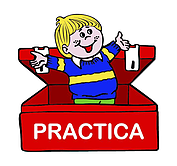“Babies are such a nice way to start people.” ~Don Herrold
The job that parents have of shaping and influencing the life of another human being must surely be the most important thing that anyone can do.
Every parent needs to know 3 things:
- What should my child be able to do at his age?
- How will I know whether he is on par?
- What can I do to help him if he isn’t?
Books are so vague and inconsistent on what a typical child should be able to do at every age (milestones) that it is practically impossible to get a clear answer to these questions.
Parents feel ill-prepared. As a result many shift the responsibility of making sure that their child develops to his full potential onto caregivers and teachers. But it’s clear from experience that this is not a safe option and actually unfair to the teacher, who is usually responsible for a large number of children.
The Practica Programme uses the basic principles of neuro-behavioural science as a starting point to give parents a practical tool that they can use to help their children to develop to their full potential during the formative years.
The basic principles of our approach:

- Your child’s brain is wired over time. As a result he is able to do new things from time to time that he wasn’t able to do earlier in his life.
- Although children generally develop along the same series of steps, individual children may progress from one step to the next at a somewhat faster or slower rate.
- By giving attention to what your child is learning to do for the first time, you can track, on a basic level, how his brain is being wired and where he finds himself on the road to maturity.
- You can then adapt the games that you play with him to align with his individual needs.
How is this practically done:
- The Practica Parents’ Guide provides you with an extensive list of activities that a typical child of your child’s age will be able to master and enjoy.
- Every activity is clearly linked to an area of development so that you can discover your child’s strengths and weaker areas by looking at how he responds to the various activities. For example: If he finds the games that focus on developing balancing skills really easy, but struggles with the memory games, you can take this as evidence that ‘balancing skills’ is a strength and ‘memory’ is a weaker area.
- You can then respond by re-capping the ‘memory activities’ listed for younger children, before coming back to the activities listed for your child’s actual age-group. This way you deal with weaker areas early on.
- On the other hand, if your child is so advanced in an area that he is bored with the activities that focus on that area, you can respond by moving on to more advanced activities, even if these are recommended for the following age-group.
Be careful not to rush your child’s natural development:
Repeat the games listed for his age for as long as he isn’t bored with it. The fact that he is still enjoying the games is a sure sign that he is still benefitting from them.
Your child will never be this age again. The more you repeat the games that match his level of development, the denser you will be building the neural networks that are now naturally taking shape in his brain.
Benefits of being able to track your child’s strengths and weaker areas:
It is far less likely that your child will fall behind in school one day if you deal with weaknesses early on, while his brain is most susceptible to the impact of educational stimulation.
It will be much easier to help him to develop to his full potential if you know what his special talents are from an early age and are able to provide a more challenging environment for him .
It will be easier to relax and enjoy your child. The better prepared you are for your role as a parent, the more confident you will be.
